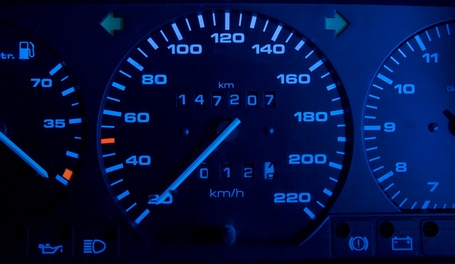
A Lincoln MKX uses a variety of diagnostic systems, including the second generation On-Board Diagnostic System, Anti-Lock Brakes (ABS) and Supplemental Restraints. Each of these system has a dedicated trouble-indicating light on the vehicle's dashboard. The instrument cluster will also feature other warning lights, like for the gas level. These lights will help you figure out a Lincoln MKX's problems, once they arise. In many cases, you will need diagnostic hardware for in-depth troubleshooting. Some code readers, like those for Supplemental Restrains System air bags, are not easily available to the general public.
Sit behind the Lincoln MKX's steering wheel and insert your key into the ignition. Start the vehicle's engine.
Watch the Lincoln's dashboard and instrument panel. All of the warning indicator lights will flash on and then cycle off quickly.
Note any light that remains lit. Those lights will tell you where the Lincoln MKX is experiencing problems. For example, if the gas light is on, you're in need of fuel. If the ABS brakes or the check engine light is on, you will need to use a hand-held diagnostic device or code reader.
Turn the Lincoln MKX's engine off. Look beneath the steering wheel and locate the vehicle's data link connector. Connect a diagnostic cable to the DLC outlet, and then connect the cable to your hand-held diagnostic device.
Turn the diagnostic device on. Turn the Lincoln's electrical system on by turning the ignition key to the "On" position. Some diagnostic devices will also need the engine running, but this depends on the diagnostic system you are interacting with, as well as on the brand and type of device you are using.
Enter a trouble code retrieving command. For most scanners, this would be a "Read" or "Scan" command. However, diagnostic devices do not all function the same. Refer to the exact instructions that came with your particular diagnostic device.
Copy all the codes retrieved onto a separate sheet of paper. Then, shut the device down and turn the engine and/or electrical system off.
Look up the definitions for the trouble codes you have copied. Many of these codes will be listed in your device's manual. However, some manufacturers do not provide these codes. Also, most OBD-II scanners only offer the generic codes standard to all vehicles. Lincoln uses a separate set of OBD-II trouble codes (see Resources). Most coding definitions can be found online, but they also can be found in a Haynes or Chilton manual.
Copy the definitions next to corresponding trouble code. Then, refer to this list if you plan to troubleshoot the Lincoln yourself. For example, OBD-II codes will specify which system is experiencing faults. So, if you are confronted with a code involving the Exhaust Gas Redirection system, troubleshoot the entire EGR system. Some systems, like the brakes or air bags, are extremely complex and should be left to a trained professional.
Keep the list codes. It is a list of problems that have occurred in your vehicle. Should you need to involve a mechanic, this list will keep you from having to pay diagnostic fees.